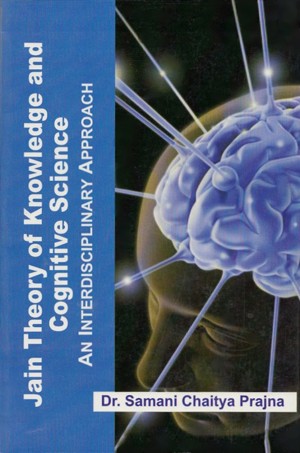Knowledge is been etymologically defined by Nandi Cūrṇi[4] as follows:
- ṇajjai aṇeṇeti nāṇaṁ: The instrument through which anything is known is knowledge.
- ṇātīti nāṇaṁ: Knowing is knowledge.
- ṇajjati etaṁhīti nāṇaṁ: That, in which something is known is knowledge.[5]
These definitions basically answer three important questions about knowledge, i.e. what is knowledge, what is the means of knowledge and where is it known. The single response to all the above questions is knowledge. There is hardly any line of distinction between the soul and the knowledge. Knowledge is an inalienable characteristic of the soul. The knowledge is knower, knowledge itself is means of knowledge and finally knowledge itself is the result of knowledge.
Soul possesses infinite knowledge, infinite intuition, infinite bliss and infinite energy, but in worldly condition, These characteristics are never completely revealed. Living beings have the capacity of knowing all the objects of world in its true form but because of the karmic veiling, this power of knowing is obstructed and restricted. Thus, only partial knowledge manifests. The cloud of karma covers the sun of the self but they are not strong enough to destroy the nature of the soul. Some fraction of knowledge would always remain uncovered. If this is not the case a there would be no difference between living and non-living being[6]. Thus, the salient feature of the jiva according to Jainism is to know. This ability is sometimes termed as upayoga or many a times also as cetanā. The definition of the soul (jīva) as consciousness is therefore based on the substantial stand point, which integrates cetanā (sentience) and upayoga (conscious activity). Consciousness is concomitant with intrinsic nature of jiva. The words upayoga (conscious activity) and cetanā (consciousness) are used parallel by Jain scholars. Detailed descriptions of both are available in Jain texts.
The terms cetanā and upayoga however have been distinguished by Kundakunda in Pañcāstikāya (1st Cent A.D.) as the former to be an attribute and the later to be a mode. Veda and vijñāna are the terms of Bhagavaī with the meaning leading to consciousness containing knowledge The same is true when Kundakunda used two the terms like cetanā and upayoga having similar meanings. Umāsvāti (1st Cent. A.D.) followed the tradition of Kundakunda defining jiva which has been divided in two aphorisms as follows ' uaogalakkhaṇaṃ jiva'. Conscious activity is the characteristic of a living being. This is further explained as ' cetanālakkhaṇo jiva'. Consciousness is the characteristic of living being.
Apart from the above said descriptions of the main texts, there exists elaborate explanation about the nature of jiva in commentaries too. In Tattvārtha Rājavārtika (720 A.D.) for example, consciousness is explained as the very nature of the living beings, as it is stated that jīvasvabhāvaścetanā.[7] Here upayoga means to know and upayoga subsists in cetanā (consciousness). Consciousness is a kind of energy and upayoga is its utilization.[8] Dhavalā (10th- 11th Cent. A.D.) defines upayoga as the acquisition of self and others.[9]
This definition is a very important definition from biological point of view because often living beings are defined in Biology as one who can respond to the stimulus. The above definition of Dhavalā accepts the biological definition partially as that which receives the stimulus is living being. Some organisms may not be able to respond to the stimulus but all organisms at least receive the stimulus.
The terms such as consciousness, (caitanya) sensitivity, irritability are included in 'upayoga'. The state in which the being becomes the knower is the state of upayoga [10] Consciousness is a basic attribute of jiva or an organism. In the commentaries of Tattvārtha Sutra, however, the living beings; embodied or disembodied has been defined in terms of capacitive (bhava) and functional (karaṇa) consciousness as upayoga.
Consciousness has been studied in current Psychology. It is said to be an abstract construct involving subjective private experiences of two primary (perceiving and feeling) and two secondary (thinking and willing) functions. These are related with sensations and emotions. It is the response of an organism to stimulants. As per the Jain texts such as described in Dhavalā, the basic attribute of life is sensation. It is not the response of an organism to the stimulants but only the reception of the stimulants.
The consciousness is activated and supported by prāṇa and paryāpti respectively to get itself manifested. Consciousness manifests itself in the form of instincts technically called as saṁjñā in Jainism. Therefore, the comprehension of the concept of jiva in Jainism is fully associated with the different concepts such as upayoga, paryāpti, prāṇa and saṁjñā. The present chapter deals with each of the above concepts in brief and the further details would be discussed in the later chapters as and when required.
To present a lucid description of jiva, Jain Acāryas have used the nine characteristics of jiva. Acārya Nemicandra Sidhanta Shastri (11th cent. A.D) in his text Dravya Saṅgraha[11] has explained all these nine characteristics in thirteen verses. The second of these nine characteristics is upayoga. Here, upayoga here primarily means manifestation of consciousness into intuition (darśanopayoga) and knowledge (jnānopayoga). Thus, it is understood that this manifestation of consciousness is the primary or main characteristic of living in Jain philosophy. The aphorisms like ' upyogalakṣaṇaṃ and cetanālakṣaṇo jīvaḥ ' indicate towards this concept clearly.
In Biology, living beings are described in the terms of its visible characteristics. Out of these, some are physical and others are psychical- such as sensation, irritability etc. Still, consciousness remains the chief characteristic of the soul, whether in the form of upayoga or irritability.
The term upayoga is defined by Acharya Tulsi as:
'cetānavyāpāraḥ upayogaḥ'[12]
'cetanā jñanadarśanātmikā
tasya vyāpāraḥ pravṛttirupayogaḥ'
Cognitive activity of consciousness is the functional consciousness. Consciousness consists of knowledge and intuition. Conscious activity is the application of the same.' It is stated in Biology that the characteristic of sensitivity is possessed by even a single celled organism[13] like amoeba, which has no visible sense organs. The sensitivity here refers to the ability to respond to the light, sound etc. It is the response of an organism to stimulants. As described in Dhavalā, the basic attribute of life is sensation. It is not response of an organism to the stimulants but only the reception of the stimulants or pure cognitive activity that distinguishes living from non-living being.
In the commentaries of Tattvārtha Sutra, however, the living beings, embodied or disembodied has been defined in terms of capacitive (bhāva) and functional (karaṇa) consciousness-upayoga. This shows that functional consciousness remains even after liberation. But there is a question that can a liberated soul function?
It is usually questioned that when the upayoga is defined as:
cetānavyāpāraḥ upayogaḥ.[14]
'Cognitive activity of consciousness is functional consciousness, how functional consciousness is possible in liberated state as per Jainism as there remains no activity in the state of liberation? The answer to the above question can be given through the analysis of the term vyāpāra given in the above definition. In Nyāya philosophical texts such as Nyāyasiddhāntamuktāvalī, the term vyāpāra is defined in as:
'tat janyatve sati tat janyajanakatvamiti vyāpāraḥ [15]
The word vyapāra refers to that begetting itself is the begetter of its own begetter. To make it more clear -that which is effect in itself and also cause of the effect is vyāpāra. This vyāpāra is present even in the liberated state. The 1st consciousness of knowledge begets the second consciousness of intuition which (consciousness) was itself caused by the consciousness of intuition, as defined:
cetanājñānadarśanātmikā /
tasyavyāpāraḥ pravṛttirūpayogaḥ. /[16]
'Consciousness consists of knowledge and intuition. Consciousness is the activity that is the application of the same.'
Regarding the nature of consciousness, Indian philosophers have different opinions. Some philosophies like Advaitavedānta, Sānkhya-Yoga and Buddhism regard consciousness as self-revealing because the consciousness of itself is self-evident. According to them, consciousness is self-revealing; it does not require other consciousness for its revelation. The other philosophies like Mimāmsa, Nyāya, Vaiśaṣika etc. regard consciousness as object-revealing and not self-revealing. Jain philosophy coordinates between the two ideologies and accepts consciousness as self-cum-object revealing.
Jain thinkers are of the opinion that consciousness is knowledge. As the knowledge is self-revealing, the consciousness too is self-revealing. The sun or the lamp lights itself and also lights other objects at the same time. It is, therefore self-revealing as well as object-revealing. Similarly, consciousness too is self-revealing as well as object-revealing as it enlightens itself and other objects at the same time. An object that cannot know itself, cannot reveal the other objects too. We can have the example of a pot. Being non-sentient, it can know neither itself nor other objects. Consciousness, being knowledge, is self-cum-object revealing. The words 'svaparāvabhāśi' or 'svaparaprakāśakatva' in Jain texts have been used to contradict the opinion of the people who regard consciousness as only self-revealing or only object-revealing factor. According to Jain philosophy, the knower reveals itself as well as the object which it knows. It means the knower while knowing a particular object, knows himself as the knower of that object. In other words, a knower is simultaneously aware of itself as the knower and also the object of that knowledge.
When we look into modern western philosophy of Jean-Paul Sartre (1905-1980), we find him speaking of two modes of consciousness: reflective and pre-reflective. Sartre considers all conscious episodes to posit an intentional object. Now among such intentional objects are acts of consciousness themselves. I might think about the Eiffel Tower and then think about this act itself that I have recalled that day in Paris when the first act of consciousness Act 1 took place, which has tower as intentional object is the object also of a further act of consciousness Act 2. This mode of self-awareness he calls reflective conscious or the tic self-awareness.
Jean Paul Sartre however makes an important point here that this is not the only form of self-awareness we enjoy. He claims that in addition to this reflective and explicit self-consciousness, which is just special case of an the act of consciousness positing an intentional object. We are always at least implicitly self-conscious in a special way, when we are not reflecting. Even when I was engaged in act which posited an object i.e. (Act 1) before becoming explicitly aware of itself in another act of consciousness called Act 2. Sartre would insist that this non-reflective act is implicitly aware of itself or else, it will lead to infinite regress as order to be aware of Act 2 will require act 3 and so on. This implicit self-awareness is called non-thematic awareness or non-positional awareness. When I am aware of the object, I am also aware, though implicitly and non-theatrically of my awareness of the object.[17]
All kinds of empirical (phenomenal) consciousness according to Jainism are intentional. There are two states of consciousness viz. passionate (sakaṣāya) and dispassionate (akaṣāya or vitrāga cetanā - a higher state of consciousness). In the passionate state of consciousness, it is no doubt always intentional but when there is no passion, no greed etc., the consciousness has no intention. The knowledge of whole world for it is as clear as crystal and there remains no intention to acquire any new knowledge. Therefore, there is no need to posit. Consciousness in this stage is non-intentional. Of course, until this stage is reached, the self or consciousness is positional.
The view of Sartre of that 'to know is to be a consciousness of knowing. It is in consonance with the Jain view of consciousness of objects and the self. As Acharya Hemachandra (12th century) puts it in his anyayogavyavacchedikā as:
Svārthāvabodhakṣamaevabodhaḥ
prakaśatenārtha - kathānyāthātu '[18]
'Knowledge (consciousness) that can reveal itself is capable revealing others. If it is not self-revealing, it cannot know any other object too'. That is to say-consciousness is consciousness of object only when it is the conscious of the self. Therefore, as Sartre's view of consciousness of the object and that of the self goes hand in hand with Jain view of self and other illumination. Acharya Hemachandra further explains in Pramāṇa Mimāmsa[19] that:
In the introspection 'I know the jar' and the like, the fact of cognition is as much revealed as content as the elements of subject and object. It is not possible that the cognition of object can happen to a subject, who does not know the act of cognition. It cannot be supposed that the cognition of such an act effected by second cognition is possible, as it will lead to regressus and infintum.
If we compare the same problem dealt by Sartre in his Being and Nothingness, with Jainism.[20] we see him acing the same problem as he writes 'It does not seem possible for us to accept this interpretation of the consciousness of consciousness. The reduction of consciousness of knowledge in fact involves our introduction into the subject-object dualism, which is typical of knowledge. If we accept the law of knower-known by dyad, then third term will be necessary for the knower to become known in turn and we will be faced with dilemma: either we stop at any one of the terms in the series-the known, the knower known, the knower-known by the knower etc. In this totality of the phenomenon the consciousness falls into unknown; that is we always bump up against a non-self-conscious reflection and a final term, otherwise, we must affirm the necessity of an infinite ad regressus (idea, ideae, etc.)
Hemacandra argues that if the cognition of act is made dependent upon the cognition of object, it will rise to fallacy of logical see-saw (inter dependence). That is to say that there is inconclusive condition that whether the cognition of the act of knowledge is dependent upon the cognition of object or the cognition of object is dependent upon the cognition of act.
If it is argued that if cognition is the object of cognition like jar, then it would become non-cognition (i.e. it would cease to be cognition) Hemchandra says you cannot argue like that since a cognition is felt as cognition just as self or the knower which is quite different from the known object. Nor is there, any logical absurdity in the fact that cognition is also cognizable, since it is a cognition with reference to the object and cognizable with reference to its own self (that is to say cognition cognizes its own self while as it knows the object). There is no incompatibility in the situation just as the same person is father and son at the same time. Nor can a compatibility be alleged in the action of the self upon itself, since incompatibility cannot occur in things attested to be true by direct experience.[21]
Thus the conclusion is inescapable that as cognition is invariably felt as self-revealing, it must be admitted that consciousness is cognizant of its object and its own self as well. The terms may vary but the concept remains the same that to know is to know that one knows. The terms used by Sartre as positional or reflexive and that of Jainism self-other revealing are though different, still it is a point where both philosophies integrate to complement each other.
Now, after knowing about the nature of knowledge, it is worth to know about its classifications.
Dravya Saṅgraha, V. 2 ãjivo-uvaogamao-amuttikatta sadehaparimāṇo bhottā saṃsarattho-siddho so vissasoḍḍha gala
Transcendence of Ego of Sartre, translated by F. Williams and R. Kirk Particle, p. 44-45. Cf1 W.T. Jones, History of Western Philosophy, Vol. V, edn.-II, p. 338.
Anyayayogavyavachedikā of Hemchandra, quoted from Syādvadamañjarī, of Acharya Mallisena, ed. by Jagadishchanda rashram, Agās, 1992, p. 103
 Samani Chaitya Pragya
Samani Chaitya Pragya

